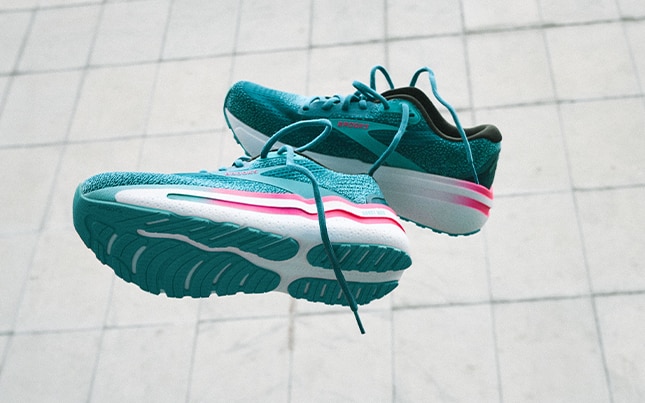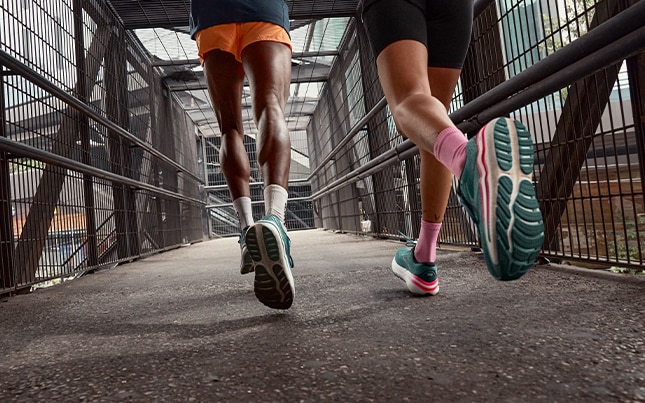Best shoes for ankle support and essential tips for ankle health and mobility

Every step you take is powered by your ankles, the unsung heroes of your body’s movement system. Ankles support your weight and absorb the impact of each stride, making their health and functionality paramount for runners and walkers.
Strong, flexible ankles not only enhance running performance but also help prevent injuries. In this article, we’ll guide you through the benefits of maintaining healthy ankles, explore how footwear impacts ankle support, and introduce you to one of our best ankle support shoes, the Ghost Max 2—our latest innovation in cushioned running shoes. We'll also provide practical tips for improving ankle mobility and techniques for relieving ankle discomfort, so you can move with confidence.
Jump to section:

Anatomy of the ankle joint
The ankle joint connects your foot to your lower leg, forming a sophisticated structure comprised of bones, ligaments, tendons, and muscles that support and facilitate movement. It’s made up of three primary bones—the tibia (shin bone), fibula (calf bone), and talus—that anchor the joint. Key ligaments like the anterior talofibular ligament (ATFL) provide crucial lateral stability and help prevent sprains. Tendons such as the Achilles tendon connect muscles to bones, essential for actions like walking, running, and jumping. Together, these components synergistically handle the considerable stress your ankle endures during daily activities, ensuring smooth, stable movements.
Benefits of maintaining strong and flexible ankles
Having healthy, limber ankles offers a host of benefits that enhance both daily life and running performance. Here are some key advantages:
- Better balance and agility: Strong ankles improve your body's stability and responsiveness, enabling quicker, more agile movements. This is crucial in sports that require sudden changes in direction and helps in maintaining balance on uneven surfaces.
- Injury prevention: Strong, flexible ankles are less susceptible to sprains and other common running injuries. By building strength and enhancing flexibility, you can protect your ankles from the stresses of daily movements and athletic endeavors.
- Boosted athletic performance: Athletes with robust ankle mobility tend to perform better across various sports. Enhanced strength and flexibility contribute to more powerful and efficient movements, from running to jumping to pivoting.
- Improved quality of life: Beyond athletic pursuits, healthy ankles improve overall mobility and independence, a crucial factor as we age. Keeping your ankles in good shape is key to preventing falls and ensuring good posture, allowing you to continue performing daily tasks with ease.

The role of footwear in ankle support
Selecting the right shoes with ankle support is crucial for providing adequate overall support and stability. Proper shoes help to distribute the force of impact evenly and reduce the load on the ankles, minimizing the risk of injury. When choosing shoes with good ankle support, look for features such as a sturdy heel counter that stabilizes the rear of the foot, a cushioned midsole for absorbing shock, and a secure upper that ensures a snug fit.
These components work together to support the ankle, prevent excessive movement, and maintain alignment. As we consider the importance of well-designed footwear, let's shine a spotlight on the Ghost Max 2, our latest innovation that incorporates these critical features, making it one of the best shoes to wear for ankle support.

Best shoes for ankle support: The Ghost Max 2
The Ghost Max 2 for men and women sets a new standard in footwear designed to support ankle stability and promote natural foot movement. Compared to its predecessor, the Ghost Max 2 features nitrogen-infused DNA LOFT v3 cushioning technology, which is even softer, lighter, and more responsive than ever before, for a smooth ride mile after mile.
The shoe’s broad base offers inherent stability for a secure feel that doesn’t interfere with a neutral stride, while the GlideRoll Rocker actively promotes smooth heel-to-toe transitions for an effortless feeling as you move. This combination effectively reduces underfoot pressure and the load on the ankles during movement. Along with protective cushioning, these design elements work together to support each step, protecting the ankle by aligning it properly and accommodating natural gait patterns.

The Ghost Max 2 has been granted the American Podiatric Medical Association (APMA) Seal of Acceptance, which recognizes products that promote good foot health. The Ghost Max 2 is also a certified PDAC A5500 Diabetic Shoe, designed to meet the footcare needs of individuals with diabetes. These recognitions underscore the shoe’s capability to provide exceptional support and protection, making it an excellent choice for anyone looking to enhance their foot health and mobility.
Curious about how the Ghost Max stacks up against the original Ghost model? Read our Ghost vs. Ghost Max comparison guide.

Practical tips for ankle mobility
Ankle mobility is essential for preventing injuries, improving balance, and supporting overall foot health. To help keep your ankles in top condition, incorporate the following dynamic warm-up exercises and post-exercise stretches into your workout routine:
Dynamic warm-up exercises:
- Ankle circles: Lift one foot off the ground and rotate your ankle slowly, making large circles. Perform 10 rotations in each direction per ankle to increase mobility and circulation.
- Ankle pumps: While seated, lift your feet off the floor and pump your ankles up and down by flexing (pointing toes up) and extending (pointing toes down) your feet. Do this 10 times to warm up the ankle joints and stretch the muscles in the calves and shins.
Post-exercise stretches:
- Towel stretch: Sit with your legs extended in front of you and wrap a towel around the ball of one foot. Gently pull the towel towards you while keeping your knee straight. Hold for 30 seconds and switch legs. This stretch targets the muscles in the calves and the underside of the foot.
- Standing calf stretch: Place your hands on a wall and extend one leg straight behind you, keeping the heel on the ground and the leg straight. Lean into the wall until you feel a stretch in the calf of the extended leg. Hold for 30 seconds and switch legs.

Pain relief techniques for ankle discomfort
When it comes to managing ankle issues, there are several effective strategies that can help alleviate pain and promote healing. Here are some key methods to consider:
- RICE protocol: For acute ankle injuries, follow the RICE protocol—rest, ice, compression, and elevation. This method can help reduce swelling, ease pain, and speed up the recovery process.
- Contrast therapy: Alternate between applying cold and warm compresses to the affected area. This method can help stimulate blood flow and reduce inflammation.
- Gentle massage: Lightly massaging the ankle can increase circulation, reduce swelling, and alleviate pain. Use gentle strokes towards the heart to enhance lymphatic drainage.
- Topical anti-inflammatory creams: Applying creams that contain anti-inflammatory ingredients can provide localized relief from pain and reduce inflammation.
If you’re experiencing chronic ankle pain, it's crucial to seek professional evaluation and treatment to prevent long-term damage. Taking proactive steps in addressing ankle discomfort not only aids in recovery but can also prevent future complications.
Prioritize your ankle health for optimal performance
Keeping your ankles strong and flexible is key to boosting your running performance and supporting your everyday routine. The Ghost Max 2 marks a leap forward in supportive footwear, giving your ankles and feet the stability and comfort they deserve
Not sure if the Ghost Max 2 is right for you? Take our shoe finder quiz to find your perfect match or visit your local running store for an expert fitting.
Shop this article
This is a carousel. Use next and Previous buttons to navigate.

Disclaimer: Our writer's advice is intended for informational or general educational purposes only. We always encourage you to speak with your physician or healthcare provider before making any adjustments to your running, nutrition, or fitness routines.
